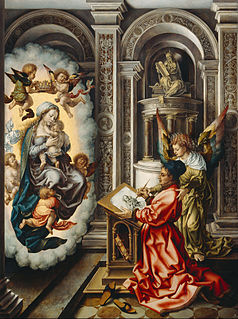
Michelangelo di Lodovico Buonarroti Simoni, known best as simply Michelangelo, was an Italian sculptor, painter, architect and poet of the High Renaissance born in the Republic of Florence, who exerted an unparalleled influence on the development of Western art. Considered by many the greatest artist of his lifetime, and by some the greatest artist of all time, his artistic versatility was of such a high order that he is often considered a contender for the title of the archetypal Renaissance man, along with his rival, the fellow Florentine and client of the Medici, Leonardo da Vinci.

David is a masterpiece of Renaissance sculpture created in marble between 1501 and 1504 by the Italian artist Michelangelo. David is a 5.17-metre (17.0 ft) marble statue of the Biblical hero David, a favoured subject in the art of Florence.

The Pietà is a work of Renaissance sculpture by Michelangelo Buonarroti, housed in St. Peter's Basilica, Vatican City. It is the first of a number of works of the same theme by the artist. The statue was commissioned for the French Cardinal Jean de Bilhères, who was a representative in Rome. The sculpture, in Carrara marble, was made for the cardinal's funeral monument, but was moved to its current location, the first chapel on the right as one enters the basilica, in the 18th century. It is the only piece Michelangelo ever signed.

The Sistine Chapel is a chapel in the Apostolic Palace, the official residence of the pope, in Vatican City. Originally known as the Cappella Magna, the chapel takes its name from Pope Sixtus IV, who restored it between 1477 and 1480. Since that time, the chapel has served as a place of both religious and functionary papal activity. Today, it is the site of the papal conclave, the process by which a new pope is selected. The fame of the Sistine Chapel lies mainly in the frescos that decorate the interior, most particularly the Sistine Chapel ceiling and The Last Judgment by Michelangelo.
David was the second king of the United Kingdom of Israel and a figure in the scriptures of Abrahamic religions.

The Capitolium or Capitoline Hill, between the Forum and the Campus Martius, is one of the Seven Hills of Rome.

Michelangelo, nickname Mike or Mikey, is a fictional character and one of the four main characters of the Teenage Mutant Ninja Turtles comics and all related media.

The Sistine Chapel ceiling, painted by Michelangelo between 1508 and 1512, is a cornerstone work of High Renaissance art. The ceiling is that of the Sistine Chapel, the large papal chapel built within the Vatican between 1477 and 1480 by Pope Sixtus IV, for whom the chapel is named. It was painted at the commission of Pope Julius II. The chapel is the location for papal conclaves and many other important services.

The Galleria dell'Accademia di Firenze, or "Gallery of the Academy of Florence", is an art museum in Florence, Italy. It is best known as the home of Michelangelo's sculpture David. It also has other sculptures by Michelangelo and a large collection of paintings by Florentine artists, mostly from the period 1300–1600, the Trecento to the Late Renaissance. It is smaller and more specialized than the Uffizi, the main art museum in Florence. It adjoins the Accademia di Belle Arti or academy of fine arts of Florence, but despite the name has no other connection with it.

The Madonna of the Stairs is a relief sculpture by Michelangelo in the Casa Buonarroti, Florence. It was sculpted around 1490, when Michelangelo was about fifteen. This and the Battle of the Centaurs were Michelangelo's first two sculptures. The first reference to the Madonna of the Stairs as a work by Michelangelo was in the 1568 edition of Giorgio Vasari's Lives of the Most Excellent Painters, Sculptors, and Architects.

Romanism is a term used by art historians to refer to painters from the Low Countries who had travelled in the 16th century to Rome. In Rome they had absorbed the influence of leading Italian artists of the period such as Michelangelo and Raphael and his pupils. Upon their return home, these Northern artists created a Renaissance style, which assimilated Italian formal language. The style continued its influence until the early 17th century when it was swept aside by the Baroque.

The Last Judgment is a fresco by the Italian Renaissance painter Michelangelo covering the whole altar wall of the Sistine Chapel in Vatican City. It is a depiction of the Second Coming of Christ and the final and eternal judgment by God of all humanity. The souls of humans rise and descend to their fates, as judged by Christ who is surrounded by prominent saints. Altogether there are over 300 figures, with nearly all the males and angels originally shown as nudes; many were later partly covered up by painted draperies, of which some remain after recent cleaning and restoration.

The Rondanini Pietà is a marble sculpture that Michelangelo worked on from 1552 until the last days of his life, in 1564. Several sources indicate that there were actually three versions, with this one being the last. The name Rondanini refers to the fact that the sculpture stood for centuries in the courtyard at the Palazzo Rondanini in Rome. Certain sources point out that biographer Giorgio Vasari had referred to this Pietà in 1550, suggesting that the first version may already have been underway at that time. The work is now in the Museum of Rondanini Pietà of Sforza Castle in Milan.
Ascanio Condivi was an Italian painter and writer. Generally regarded as a mediocre artist, he is primarily remembered as the biographer of Michelangelo.
Night is the period in which the sun is below the horizon.
Michelangelo is a 216 km diameter impact basin in the Michelangelo quadrangle of Mercury, which is named after this crater. The crater itself is named after the artist Michelangelo. It is located at 45.0°S, 109.1°W.

Michelangelo had a complicated relationship with the Medici family, who were for most of his lifetime the effective rulers of his home city of Florence. The Medici rose to prominence as Florence's preeminent bankers. They amassed a sizable fortune some of which was used for patronage of the arts. Michelangelo's first contact with the Medici family began early as a talented teenage apprentice of the Florentine painter Domenico Ghirlandaio. Following his initial work for Lorenzo de' Medici, Michelangelo's interactions with the family continued for decades including the Medici papacies of Pope Leo X and Pope Clement VII.
Tommaso dei Cavalieri (1509–1587) was an Italian nobleman, who was the object of the greatest expression of Michelangelo's love. Cavalieri was 23 years old when Michelangelo met him in 1532, at the age of 57. The young nobleman was exceptionally handsome, and his appearance seems to have fit the artist's notions of ideal masculine beauty, for Michelangelo described him as "light of our century, paragon of all the world." The two men remained lifelong friends, and Cavalieri was present at the artist's death.

The Rothschild Bronzes are a pair of early-16th century sculptures, each depicting a nude male figure riding a panther, which have been verified as being made by Michelangelo. The sculptures are believed to have been created around 1506 to 1508, before the painting of Sistine Chapel ceiling fresco but after the marble statue of David. The bronzes are now considered the only known surviving bronze works by the artist in existence. The bronzes were displayed to the public at the University of Cambridge's Fitzwilliam Museum from February to August 2015.













